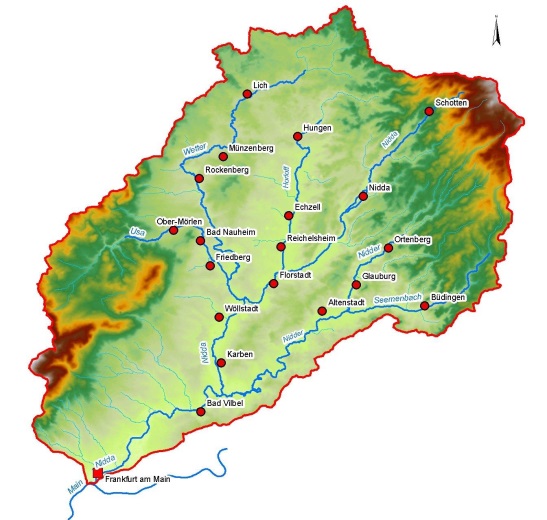NiddaMan – Sustainable Water Resources Management in the Nidda Catchment Area
- contact:
Dipl. - Geoökol. Ramona Wander
Dipl. - Geoökol. Sara Ziegler - funding:
Federal Ministry of Education and Research (BMBF)
- startdate:
05/2015
- enddate:
04/2018
Short description
The NiddaMan joint project has the aim to map out a sustainable management strategy for the water resources of the Nidda catchment area in Hesse. As planning instruments, these strategies are to be applied to water resources management practices. Within the NiddaMan project, the IWG conducts the sub-project “Scenario Developing and Modeling”.
The Federal Ministry of Education and Research (BMBF) promotes the project in the program “Research for Sustainable Developments” (FONA) as part of the funding measure “Regional Water Resources Management for Sustainable Water Protection in Germany” (ReWaM) in the funding priority “Sustainable Water Management” (NaWaM).
The sustainable management of catchment areas and water bodies, and by association the protection of their ecological functions und use, is a basic social task. For the tasks related to this subject, proven tools with different scopes are on hand. For water resources management tasks, which consider major territorial units aside from specific measures and which incorporate different aspects (contaminant influx, quality, ecological response), appropriate tools are still lacking. In the context of the project, a tool that highly considers the requirements of sustainable water resources management and therefore can be applied for integrative planning within water authorities will be developed. This will be achieved through the interdisciplinary collaboration of social scientists, natural scientists (biologists, chemists, geoecologists, hydrologists) and engineering scientists. Based on a large-scale study of substance loads in the Nidda river and its backwaters, using an emission model, the modelling of emissions will further be enhanced and linked up with a water quality model using selected problem areas. The scientific challenge of this project is to link up model components with varying spatial and time-wise scopes.
The sub-project “Scenario Developing and Modeling” adapted by the IWG, aims at modeling emissions at a higher spatial and time-wise resolution using MoRE (Modelling of Regionalized Emissions). The results will be integrated into a water quality model which subsequently allows statements on the danger potential of water segments. In close collaboration with the project partners the implementation of the project goal requires the following working steps:
- Identifying relevant input paths and spatial pollution focuses of emissions within the Nidda basin using MoRE
- High-resolution modelling of emissions in test areas which have been identified as critical water segments
- Modelling of the water quality and derivation of qualitative statements concerning the danger potential of water segments for biota
- Verification of the scalability and transferability of the approaches developed in the test areas onto the whole catchment area of the Nidda river
- Modeling of the impacts of implementation of measures and modeling of the impact of scenarios developed for demographic changes, Land-use changes and climate change on emissions and water quality using MoRE
The Goethe-University Frankfurt (coordination), University Tübingen, Technical University Darmstadt, Institute for social-ecological research (ISOE) Frankfurt, the Federal Institute for Hydrology (BfG) Koblenz, Brandt Gerdes Sitzmann Wasserwirtschaft GmbH (BGS) and Unger Ingenieure, both in Darmstadt, are partners in the NiddaMan project. Associated partners are the Hessian State Agency for Environment and Geology (HLUG) Wiesbaden, the Regierungspräsidium Darmstadt (RPDa) and the administrative district Wetterau in Friedberg.

